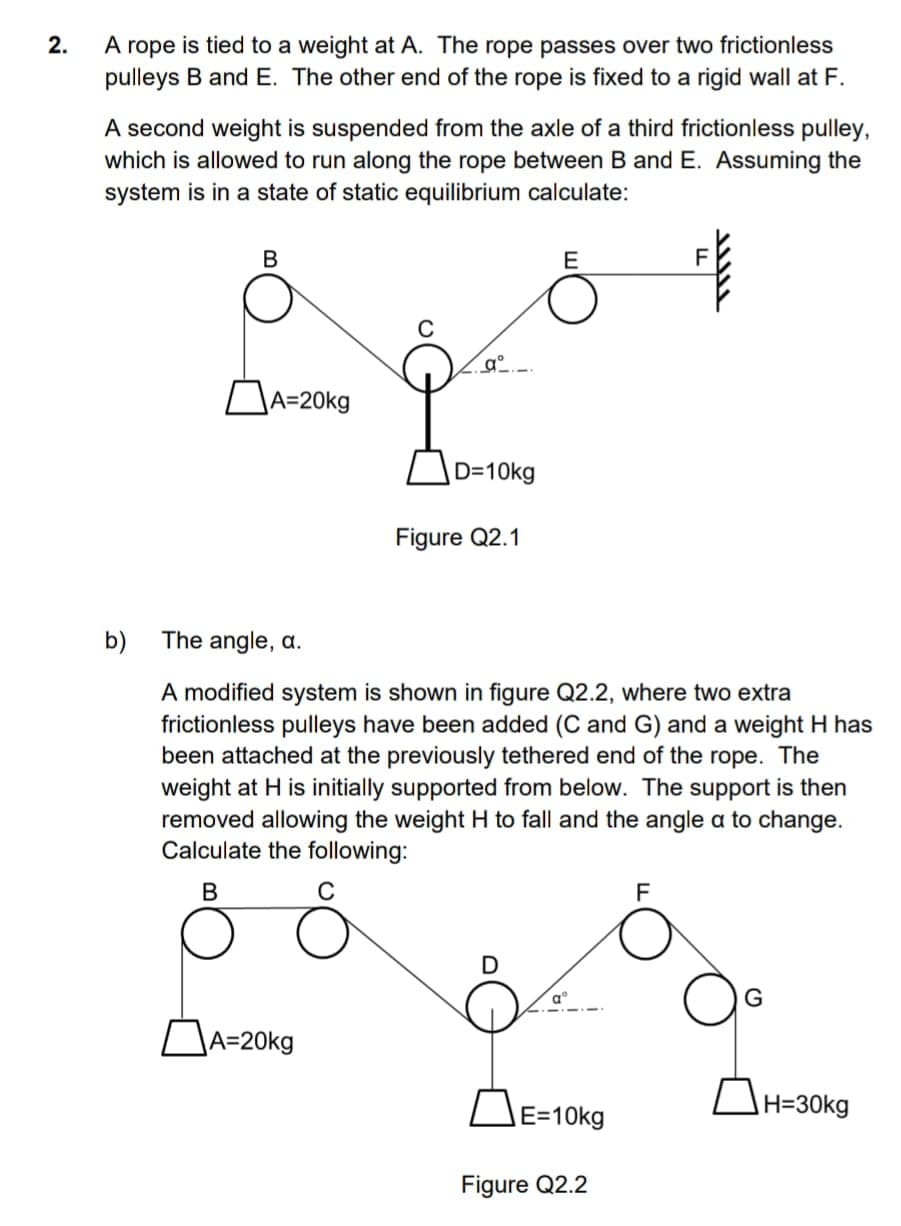2. A rope is tied to a weight at A. The rope passes over two frictionless pulleys B and E. The other end of the rope is fixed to a rigid wall at F. A second weight is suspended from the axle of a third frictionless pulley, which is allowed to run along the rope between B and E. Assuming the system is in a state of static equilibrium calculate: b) B A=20kg V... D=10kg Figure Q2.1 E F W!!! The angle, a. A modified system is shown in figure Q2.2, where two extra frictionless pulleys have been added (C and G) and a weight H has been attached at the previously tethered end of the rope. The weight at H is initially supported from below The support is then
2. A rope is tied to a weight at A. The rope passes over two frictionless pulleys B and E. The other end of the rope is fixed to a rigid wall at F. A second weight is suspended from the axle of a third frictionless pulley, which is allowed to run along the rope between B and E. Assuming the system is in a state of static equilibrium calculate: b) B A=20kg V... D=10kg Figure Q2.1 E F W!!! The angle, a. A modified system is shown in figure Q2.2, where two extra frictionless pulleys have been added (C and G) and a weight H has been attached at the previously tethered end of the rope. The weight at H is initially supported from below The support is then
Chapter2: Loads On Structures
Section: Chapter Questions
Problem 1P
Related questions
Question
Need solution urgently

Transcribed Image Text:2.
A rope is tied to a weight at A. The rope passes over two frictionless
pulleys B and E. The other end of the rope is fixed to a rigid wall at F.
A second weight is suspended from the axle of a third frictionless pulley,
which is allowed to run along the rope between B and E. Assuming the
system is in a state of static equilibrium calculate:
b)
B
A=20kg
gº
A=20kg
D=10kg
Figure Q2.1
E
The angle, a.
A modified system is shown in figure Q2.2, where two extra
frictionless pulleys have been added (C and G) and a weight H has
been attached at the previously tethered end of the rope. The
weight at H is initially supported from below. The support is then
removed allowing the weight H to fall and the angle a to change.
Calculate the following:
B
C
E=10kg
Figure Q2.2
F
F
G
H=30kg
Expert Solution
This question has been solved!
Explore an expertly crafted, step-by-step solution for a thorough understanding of key concepts.
Step by step
Solved in 2 steps with 1 images

Knowledge Booster
Learn more about
Need a deep-dive on the concept behind this application? Look no further. Learn more about this topic, civil-engineering and related others by exploring similar questions and additional content below.Recommended textbooks for you


Structural Analysis (10th Edition)
Civil Engineering
ISBN:
9780134610672
Author:
Russell C. Hibbeler
Publisher:
PEARSON

Principles of Foundation Engineering (MindTap Cou…
Civil Engineering
ISBN:
9781337705028
Author:
Braja M. Das, Nagaratnam Sivakugan
Publisher:
Cengage Learning


Structural Analysis (10th Edition)
Civil Engineering
ISBN:
9780134610672
Author:
Russell C. Hibbeler
Publisher:
PEARSON

Principles of Foundation Engineering (MindTap Cou…
Civil Engineering
ISBN:
9781337705028
Author:
Braja M. Das, Nagaratnam Sivakugan
Publisher:
Cengage Learning

Fundamentals of Structural Analysis
Civil Engineering
ISBN:
9780073398006
Author:
Kenneth M. Leet Emeritus, Chia-Ming Uang, Joel Lanning
Publisher:
McGraw-Hill Education


Traffic and Highway Engineering
Civil Engineering
ISBN:
9781305156241
Author:
Garber, Nicholas J.
Publisher:
Cengage Learning